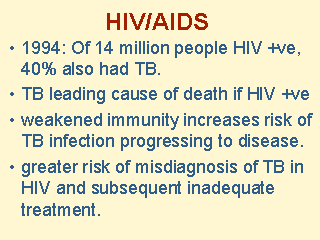 |
In the 1980s, New York City discontinued TB surveillance and
treatment programs introduced in the 1920’s to control the TB epidemic, then
decimating the slum immigrant populations. At the same time HIV incidence began to rapidly
increase. The result has been a rapid upswing in the incidence of TB during this decade,
mainly among, but not limited to, HIV positive people, a significant proportion of which
is MDRTB.
Between 1992 and 1997 following the introduction of DOT and other controls on treatment
adherence, new cases of TB in New York decreased by 55% and MDRTB by 87%
(NEJM 1999;340:359-73).
|
